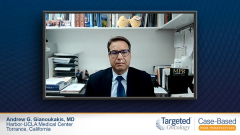
Lenvatinib Data for RAI-Refractory DTC
Episodes in this series

Andrew G. Gianoukakis, MD: The trial that led to the FDA approval of lenvatinib was the phase 3 SELECT trial. This was a placebo-controlled, blinded trial where patients were randomized 2:1 to lenvatinib versus placebo. The primary outcome measure of efficacy was progression-free survival, and the secondary outcomes were overall survival and safety. Approximately 65% of patients in the trial achieved either a partial or complete remission. Over 95% of patients had a benefit from the medication, if including patients who had stable disease. That was notable because all patients enrolled in the trial had to be radioiodine refractory and have progressive disease by RECIST criteria.
Essentially all patients in the phase 3 trial, irrespective of subgroup, benefited from lenvatinib use, including younger and older patients, patients with and without lung metastases, patients with and without bone metastases, and subcategories of patients with noted genetic mutations, such as the BRAF mutation. After the initial trial, a subgroup analysis of patients with lung metastases showed an overall survival benefit. All of the post hoc studies and subgroup analyses need to be taken with a grain of salt. However, this 1 study did show an overall survival for patients with lung metastases.
Similarly, a subgroup post hoc analysis looking at patients who responded—being patients who achieved partial remission or complete remission—showed that the duration of response could be extended out to over 30 months. The initial SELECT trial showed a progression-free survival of 18 months. However, when you look at the patients who achieved a partial or complete response, 65% of the total group, the duration of response lasted close to 33 months. Within 2 to 4 months of initiating lenvatinib, you can identify patients who are responders and can expect their duration of response to be greater than 30 months—nearly 3 years—which, in the scenario of metastatic radioiodine-refractory disease, is a good duration.
Regarding overall survival, there has been a study out of Korea showing that there is an overall survival [benefit] with lenvatinib when used as salvage therapy after progression of disease on sorafenib. In general, however, proof of overall survival with these agents has been difficult to show in well controlled, high quality studies, primarily because of the allowance of patients in the placebo arm to cross over to active treatment once they progress. That limits the ability to show efficacy past the initial progression-free survival noted and to show overall survival.
Transcript edited for clarity.
Case: A 73-Year-Old Woman With Differentiated Thyroid Cancer
Initial Presentation
- A 73-year-old woman complains of a “lump” on her neck, with occasional swelling and dysphagia
- PMH: obese; BMI 32
- PE: palpable, nontender neck mass
Clinical Work-up and Initial Treatment
- Labs: TSH 1.1 µU/mL; all others WNL
- Ultrasound of the neck revealed a 3.0 cm mass in the right lobe of the thyroid; several suspicious lymph nodes ranging from 0.2-3.0 cm in size
- Ultrasound-guided FNAB: confirmed papillary thyroid carcinoma
- Patient underwent total thyroidectomy with bilateral central neck dissection
- Pathology: 3.0 cm papillary thyroid cancer arising in right lobe of the thyroid, 2 of 5 positive central compartment lymph nodes, largest 1.4 cm, positive extra nodal extension
- StageT2N1MX; ECOG PS 0
Subsequent Treatment and Follow-up
- She was treated with radioactive iodine
- Levothyroxine to suppression was added to treatment regimen
- Follow-up at 6 months TSH 0.4 µU/mL, thyroglobulin 4 ng/mL
- Neck US unremarkable
- Follow-up 12 months TSH 0.3 µU/mL, thyroglobulin 18 ng/mL
- US of the neck was unremarkable
- CT of the chest showed 10 lung nodules, largest 1.2 cm in size
- Administered radioactive iodine 150 millicuries
- Post therapy scan showed no lung or other uptake
- Follow-up at 2 years TSH 0.3 µU/mL, thyroglobulin 30 ng/mL
- Chest CT increasing number and size of lung nodules; largest 1.6 cm
- Patient was asymptomatic and deemed radioactive iodine refractory
- Systemic therapy with lenvatinib 24 mg PO qDay considered








































